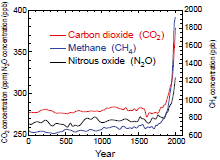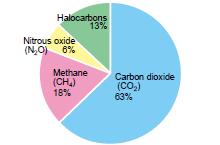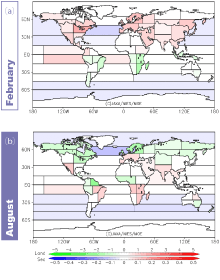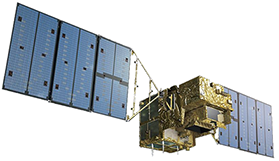[1] Goals of the GOSAT Project
[2] Instruments and Observational Methods
[3] Methods of Analyzing GOSAT Data
[4] Data Processing and Data Product Distribution
[5] GOSAT Data Products
[6] Validation of GOSAT Data Products
[7] Information and RA
[8] Organization and Plans
Due to mass consumption of fossil fuels in the expansion of industrial activities, worldwide emissions of CO2 increased considerably during the past century. As shown in Figure 3, atmospheric CO2 concentrations are rising very rapidly. CO2 has a potential to warm the atmosphere and hence an increase in the concentrations leads to a rise in atmospheric temperatures. CO2 and other chemical compounds, such as CH4, nitrous oxide, and halocarbons, are designated as greenhouse gases that are subject to emission regulations under the Kyoto Protocol. CO2 and CH4 together account for over 80 percent of the total warming effect caused by these gases (Figure 4). The increased amount of greenhouse gases in the atmosphere is thought to cause not only rises in global average temperatures but also severe droughts and frequent floods. Such climatic changes may result in enormous damages.
For these reasons, the international community is moving toward reducing greenhouse gas emissions. In the Kyoto Protocol under the United Nations Framework Convention on Climate Change, emissions reduction targets for developed nations were agreed in 1997 and came into effect in February 2005. For promoting greenhouse gas reductions worldwide, it is essential to set rational reduction goals based on sure predictions of climate change and its potential influences. At the same time, it is important to obtain accurate information on greenhouse gas emissions on national basis and evaluate their reduction measures based on that knowledge.
The primary purpose of the GOSAT Project is to estimate emissions and absorptions of the greenhouse gases on a subcontinental scale (several thousand kilometers square; see Figure 5 for an example) more accurately and to assist environmental administration in evaluating the carbon balance of the land ecosystem and making assessments of regional emissions and absorptions. Through analyzing the GOSAT data, scientists will accumulate new knowledge on the global distribution and temporal variation of the greenhouse gases, as well as the global carbon cycle and its influence on climate. These new findings will be utilized for predicting future climate change and assessing its impact. The Project also aims to expand existing earth observing satellite technologies, develop new methodologies for greenhouse gas measurement, and promote technological development necessary for future earth-observing satellites.
[1] Goals of the GOSAT Project

Figure 3. Changes in atmospheric concentrations of primary greenhouse gases. (Source: IPCC Fourth Assessment Report)

Figure 4. Contributions of primary greenhouse gases to the increase in atmospheric temperatures. The above figures are based on the best estimates of radiative forcing from 1750 to 2005. (Source: IPCC Fourth Assessment Report)

Figure 5. Sample estimates of global CO2 sources and sinks (gC/m2/day). a) February; b) August, 2012
Privacy Policy | Link | Glossary
Copyright © National Institute for Environmental Studies. All Rights Reserved.















